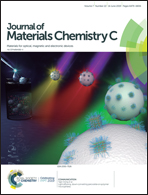Refractive index modulation in metal oxides arising from chemically induced free carriers and its application in gas sensing†
Abstract
Many semiconducting metal oxides exhibit electrical properties sensitive to surface chemical reactions and are therefore utilized to build highly sensitive gas detectors. Little attention has been paid, however, to correlated gas induced optical property changes. The few studies focused on this topic often show only weak optical gas responses for the investigated metal oxides in the observed wavelength ranges, even though strong electrical signals are expected. Here, to elucidate this apparent discrepancy, tungsten oxide is utilized as a model material. With a series of tungsten oxide photonic crystals the hydrogen induced strong refractive index dispersion of the oxide is reconstructed by analyzing its optical response. It is revealed that gas induced free carrier absorption is the dominant mechanism for the refractive index modulation. This modulation is strong in the near infrared but weak in the visible regime, which explains the relatively low optical responses observed so far. By utilizing photonic crystals with a near infrared optical band-gap, the optical response of the tungsten oxide/hydrogen system presented here increases by one order of magnitude. Furthermore, the presented mechanism is suggested to be applicable for optical gas sensors based on other metal oxides as well, allowing targeting other gases than hydrogen.

- This article is part of the themed collection: Photonics


 Please wait while we load your content...
Please wait while we load your content...